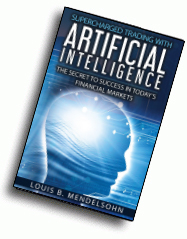Supercharged Trading with Artificial Intelligence: The Secret to Success in Today’s Financial Markets
(Marketplace Books, 2018)
Written by: Louis B. Mendelsohn
There is a new dawn on the technological horizon that is rapidly sweeping across the world. After being in a twilight state for decades since the advent of ‘thinking machines’ more than half a century ago, glimpses of bright sunlight have appeared on the horizon only to be followed by periods of darkness. Now, finally, sunrise is upon us as the ‘Age of Artificial Intelligence’ brightens the skies.
There are many reasons why it has taken so long for this day to arrive, which will be discussed in more detail in this book. Now, all the necessary pieces to the AI puzzle are falling into place. This transformative technology in which powerful computers can be taught to think on their own and learn about various aspects of reality is on the cusp of redefining life, culture and society as we know it.
This phenomenon is already bringing about dramatic changes affecting virtually every aspect of human endeavor. It is helping computer scientists and others to solve problems that were previously thought to be intractable to human intervention and research. Now, through collaboration between humans and intelligent computers – ‘putting their heads together’ so to speak – no clearly defined and identifiable problem space is beyond the purview of artificial intelligence.
My purpose in writing this book is first and foremost to introduce the reader to artificial intelligence in easy-to-understand terms, highlighting its inception, and its on-again, off-again history throughout the last half of the 20th century. You’ll learn about what it is, how it works and why it is just now breaking the technological barrier and becoming so ubiquitous worldwide, when it’s been around for so very long.
Innovative projects and AI applications already funded and being applied to a broad spectrum of industries from A to Z will be highlighted, so that you get a good sense for just how extensive and pervasive the application of artificial intelligence has become in just the last several years. Today, even my young grandchildren know and read about artificial intelligence and use it daily in their lives as they boss Alexa® around giving her commands and requests for information. To them, engaging with AI through their use of personal electronic assistants is as normal and non-threatening a part of childhood as learning how to control yoyos was for me back in the early 1950s when I was my grandchildren’s age. Now, instead of learning how to play ‘fish’ with a deck of cards or Monopoly® on a game board, today’s youth view computers no differently than they do toasters. They are simply household gadgets that make their lives more exciting and interesting.
I first learned about artificial intelligence in the mid-1960s while a student at Carnegie Mellon University in Pittsburgh, when AI was still in its infancy. Then, many years later in the late 1980s, as the ‘global economy’ was first emerging, I realized that the existing methods that I had been using to analyze the financial markets needed to be broadened, as formerly independent domestic markets became increasingly globalized and interconnected with one another. That’s when I began looking into how artificial intelligence, and specifically the pattern recognition and forecasting capabilities of ‘artificial neural networks’, could be applied to the global financial markets, which is the problem space that has most interested me intellectually throughout my adult life.
Since then, as the global economy, fostered by advancements in telecommunications, information technologies and data analytics, contributed to the globalization of the financial markets themselves, I realized that stock and commodity market analysts, particularly technicians who practice ‘technical analysis’, would need to be able to perform ‘intermarket analysis’ on global market data, to ferret out the effects of related markets on specific primary markets of interest.
Intermarket analysis gives traders and investors a serious competitive edge over others who still limit their analysis to each individual market by itself (without taking into account the impact of related markets), using various charting tools like support and resistance lines, or relying on lagging technical indicators like moving averages.
Now, traders and investors have the ability to put the power of neural networks to work for them. This form of artificial intelligence empowers traders with a unique insight into each primary market’s expected price movements in the near term. This feat is accomplished by ‘training’ neural networks to find hidden patterns and non-linear relationships that link markets to one another.
Then the trained neural networks get updated daily to make highly accurate short-term forecasts of price movements and changes in trend direction of each primary market being analyzed. This leads to more decisive and profitable trading decisions by reducing, if not eliminating, the risk of getting caught blindsided on the wrong side of a trade due to an abrupt price move and change in trend direction. By incorporating intermarket analysis, through the use of trained neural networks, as an integral part of your trading strategies, instead of being restricted to examining a single market’s price charts visually, or relying on lagging technical indicators, the interconnections and linkages between today’s global markets will work to your benefit, and not to your financial detriment.
Geared for individual traders and investors who want to use technical analysis to analyze financial markets and make trading decisions, this book explains how still widely-used, yet outdated, single-market, trend-following (lagging) technical indicators can be transformed mathematically into powerful, predictive (leading) indicators.
This is accomplished by processing daily global market data through the pattern recognition and forecasting capabilities of trained neural networks. This transformative, forecasting technology will allow you to predict ahead of time what various primary markets are expected or likely to do over the next few days with unprecedented forecasting accuracy, so you can act with confidence to put on or take off trades.
The book should be of interest to both experienced traders and investors, as well as newcomers to the financial markets, who are unfamiliar with artificial intelligence.
- Chapter 1 – examines the overall field of artificial intelligence since its inception, which only recently has become recognized as what is shaping up to be the most significant and transformative technology of our lifetimes. It also covers numerous applications currently being commercialized in such fields as autonomous vehicles, healthcare, agriculture and the military.
- Chapter 2 – offers a broad overview of the two most successfully applied forms of artificial intelligence known as machine learning and deep learning. These two learning algorithms involve the development and training of artificial neural networks, which are mathematical constructs patterned after the structure and function of the human brain’s neurons.
- Chapter 3 – presents a brief history of technical analysis and how it’s been conducted since before the advent of personal computers, with its scope limited to analyzing each individual market by itself (an approach referred to as ‘single market analysis’), while ignoring the effects of related markets. It highlights the limitations and serious deficiencies of single market analysis methods, particularly trendfollowing, lagging technical indicators in the age of artificial intelligence.
- Chapter 4 – examines an early attempt (known as linear correlation analysis) by technical analysts to move beyond single market analysis. While still widely-used by traders in both the equities and futures markets to compare the price history of any two markets to one another at a time, this simplistic form of intermarket analysis breaks down once more than two ‘inter-markets’ are to be examined at the same time with regard to how they are affecting a primary market.
- Chapter 5 – details some of the reasons behind the emergence of the ‘global economy’ and the concurrent globalization of the financial markets. It discusses why it’s now so urgent for serious traders and investors to implement a more robust form of intermarket analysis than simply finding linear correlations between any two markets at a time.
- Chapter 6 – presents my firm’s AI software, VantagePoint, as one example of how artificial intelligence is being applied to financial market analysis. It discusses how to implement intermarket analysis using deep learning neural networks that find the hidden patterns and relationships between global markets, and shows how VantagePoint uses this data to identify emerging trend direction changes and to make highly accurate, short term, forecasts of primary markets based on these hidden patterns and relationships with multiple related markets.
- Chapter 7 – discusses several different trading strategies that can be applied using predictive, leading technical indicators derived from the application of neural networks to global financial market data. It details how, through the use of artificial intelligence’s forecasting capabilities traditional, trend-following, lagging technical indicators such as moving averages, RSI, MACD and stochastics can be transformed, mathematically, into leading, predictive indicators that perform far more effectively.
- Chapter 8 – details several trade-entry trading strategies, including options strategies, that can be developed through the application of intermarket analysis powered by artificial intelligence. VantagePoint is used for presentation purposes, but these types of strategies can be created elsewhere by traders interested in developing and training their own artificial intelligence-based trading platforms – it just takes a lot of time and trial and error.
- Chapter 9 – looks toward the future in terms of how artificial intelligence applied to the financial markets and intermarket analysis can help traders and investors improve their trading performance and help build their wealth.
In summary, this book introduces the reader to the field of artificial intelligence and how it’s being applied worldwide throughout virtually every industry including the military. It discusses the globalization of the world’s financial markets that began in the late 1980s, and why artificial neural networks are ideally suited to the task of performing intermarket analysis and developing and implementing profitable trend-forecasting trading strategies in the global equities, options, futures, ETF, cryptocurrency and Forex markets.

ABOUT THE AUTHOR
Louis B. Mendelsohn is Chief Executive Officer of Market Technologies. Mr. Mendelsohn began trading equities in the early 1970s, followed by stock options. Then, in the late 1970s he started trading commodities, as both a day and position trader. In 1979, he formed Market Technologies to develop technical analysis trading software for the commodity futures markets.
In 1983, Mr. Mendelsohn pioneered the first commercial strategy back-testing and optimization trading software for microcomputers. By the mid-1980s these capabilities had become the standard in microcomputer trading software for both equities and futures, fueling the growth of today’s multi-million dollar technical analysis software industry.
Recognizing the emerging trend toward globalization of the world’s financial markets, in 1986 Mr. Mendelsohn again broke new ground in technical analysis when he developed the first commercial intermarket analysis software in the financial industry for microcomputers. Building on his extensive research in the 1980s involving intermarket analysis, in 1991 Mr. Mendelsohn released VantagePoint Intermarket Analysis Software, which makes short term market forecasts based upon the pattern recognition capabilities of neural networks.





